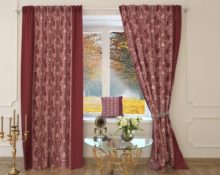 At the end of the 19th century, in country noble estates, hotels, restaurants and cultural institutions, window decorations were not an ordinary addition to the interior, but themselves became a key part of it. The curtains and curtains made from a variety of satin - satin (a less popular name - satinette) looked most advantageous and expensive. After 100 years, this fabric has returned to the interior; today it is used for sewing classic and modern curtains, porters, and drapes.
At the end of the 19th century, in country noble estates, hotels, restaurants and cultural institutions, window decorations were not an ordinary addition to the interior, but themselves became a key part of it. The curtains and curtains made from a variety of satin - satin (a less popular name - satinette) looked most advantageous and expensive. After 100 years, this fabric has returned to the interior; today it is used for sewing classic and modern curtains, porters, and drapes.
The material for sewing light, flowing curtains that can be easily laid with frills called “saten” is a type of satin that has its own differences and advantages.
What are satin curtains
Beautiful, with embossed stripes and a medium-density texture - these are the key features of satin curtains. Despite its ability to diffuse light, the front side of satin does not produce glare.
An equally important feature for consumers is that high resistance to dust ensures comfortable care of window textiles - curtains and drapes do not need to be washed every month, vacuumed or ventilated regularly.
Characteristics
 In places where fabrics for sewing home textiles are sold, customers can purchase satin bundles of different widths - from 150 to 360 cm, depending on the size of the future curtains. The density of the original and durable material is from 130 g/sq.m. up to 280 g/sq.m.
In places where fabrics for sewing home textiles are sold, customers can purchase satin bundles of different widths - from 150 to 360 cm, depending on the size of the future curtains. The density of the original and durable material is from 130 g/sq.m. up to 280 g/sq.m.
Advantages
On the positive side, saten is characterized by several indicators:
- Wrinkle resistance of the material.
- High elasticity of fibers.
- Easy to care for (does not require special cleaning, washing and drying conditions).
Also, buyers of satin window textiles fell in love with it for its lightness of drapery and ability to keep its shape.
Flaws
As a textile for windows, satin has no disadvantages. It is rarely used for clothing and bedding due to its poor thermal insulation and poor ability to allow air to circulate.
How do satin curtains differ from regular curtains?
 Main difference satin or linen curtains, for example, the brightness of the printed image in the case of using photo printing technology.
Main difference satin or linen curtains, for example, the brightness of the printed image in the case of using photo printing technology.
This material also has a pleasant texture, effectively diffuses light, performs a soundproofing function and does not change its appearance for 10-15 years.
What are satin curtains made from?
The basis of satin is synthetic polyester fibers, woven using a special weaving technology - one weft (surface) thread overlaps several warp threads. As a result of this interaction of fibers, the front side of the satin sparkles with the shine of the threads, while the back side remains deeply matte.
Varieties of satin
Saten has 4 subspecies: light (used instead of tulle, a very light and delicate fabric), display (moderately dense material, from which photo curtains are often made), premium (characterized by a grainy relief surface of the front side) and satin-premium (very smooth material).
Application area of satin
 Due to its poor hygienic properties (poor air permeability), satin is often used for sewing home textiles - curtains, bedspreads, pillowcases for decorative pillows, napkins and even tablecloths.
Due to its poor hygienic properties (poor air permeability), satin is often used for sewing home textiles - curtains, bedspreads, pillowcases for decorative pillows, napkins and even tablecloths.
You can rarely see clothes made of satin - this material is used in theater circles for sewing stage costumes.
Tips for caring for satin
 A variety of satin fabric with a bright satin surface does not require special care. Wash satin products manually or using a washing machine at a temperature not exceeding 40 degrees without using chlorine-containing stain removers and bleaches. After washing, it is better to dry satin curtains outdoors in windy weather.
A variety of satin fabric with a bright satin surface does not require special care. Wash satin products manually or using a washing machine at a temperature not exceeding 40 degrees without using chlorine-containing stain removers and bleaches. After washing, it is better to dry satin curtains outdoors in windy weather.
Since the material does not wrinkle, there is no need to iron it. If you want to use an iron, the temperature of the heated device should not exceed 120 degrees, and you need to iron it from the wrong side.
Conclusion
It can be beautiful and atmospheric, like in noble mansions or in a modern style, in everyone’s home if you choose the right textiles. Curtains made of satin, in classic variations or decorated using innovative technologies in the form of photo printing on fabric, will decorate any interior. The strength, durability and affordability of this material allow it to be used for low-budget decor.


 1
1





